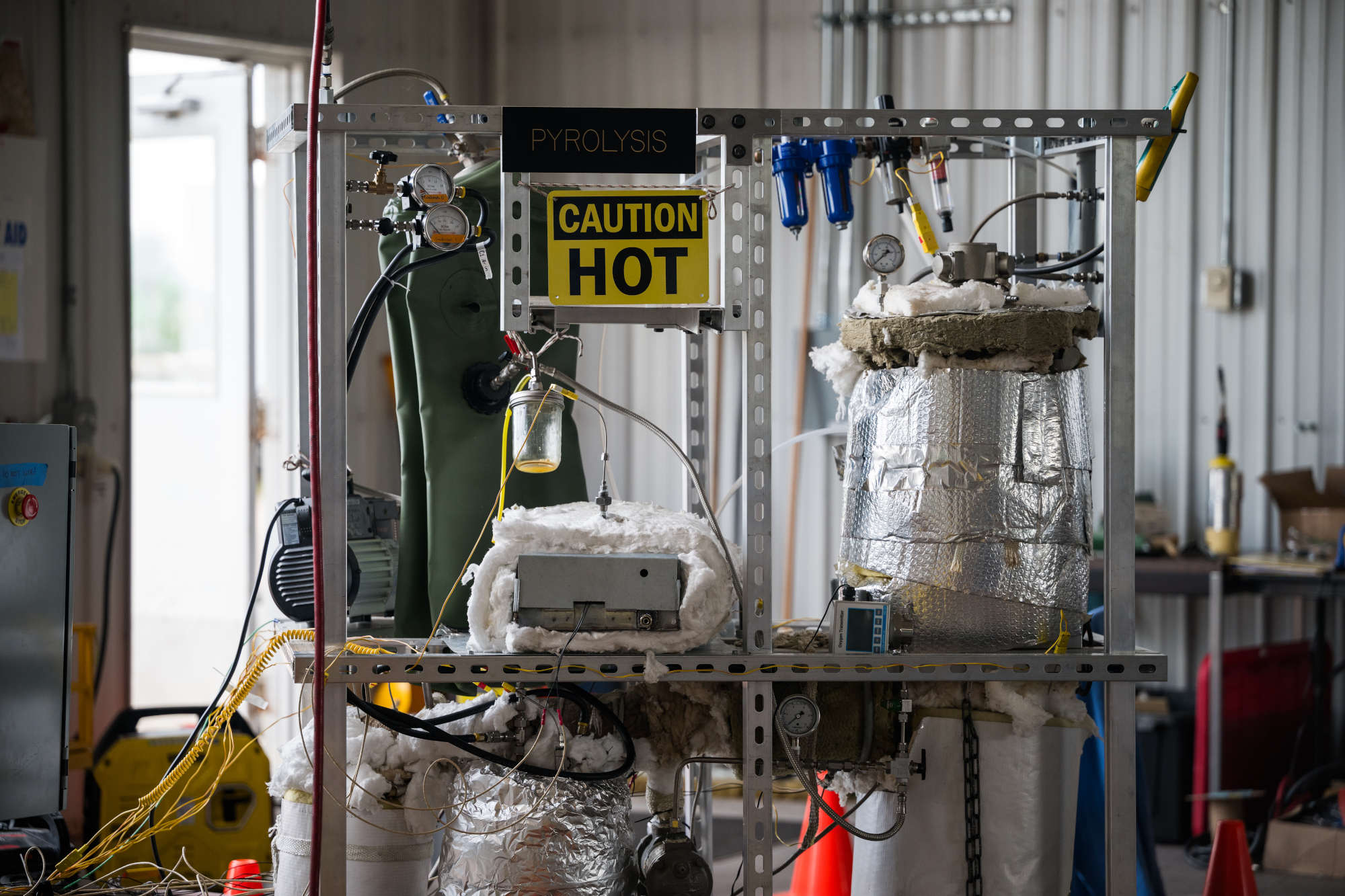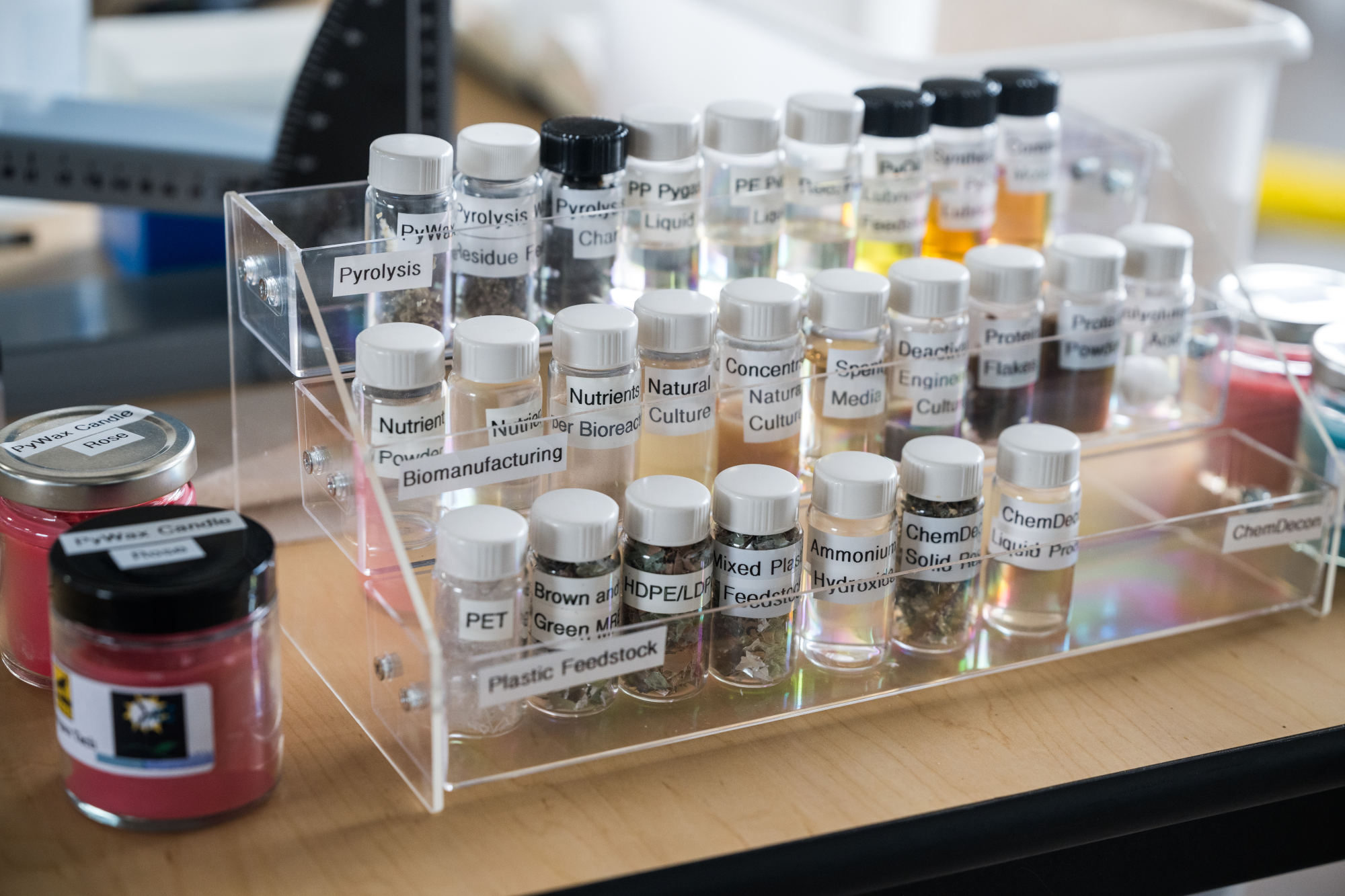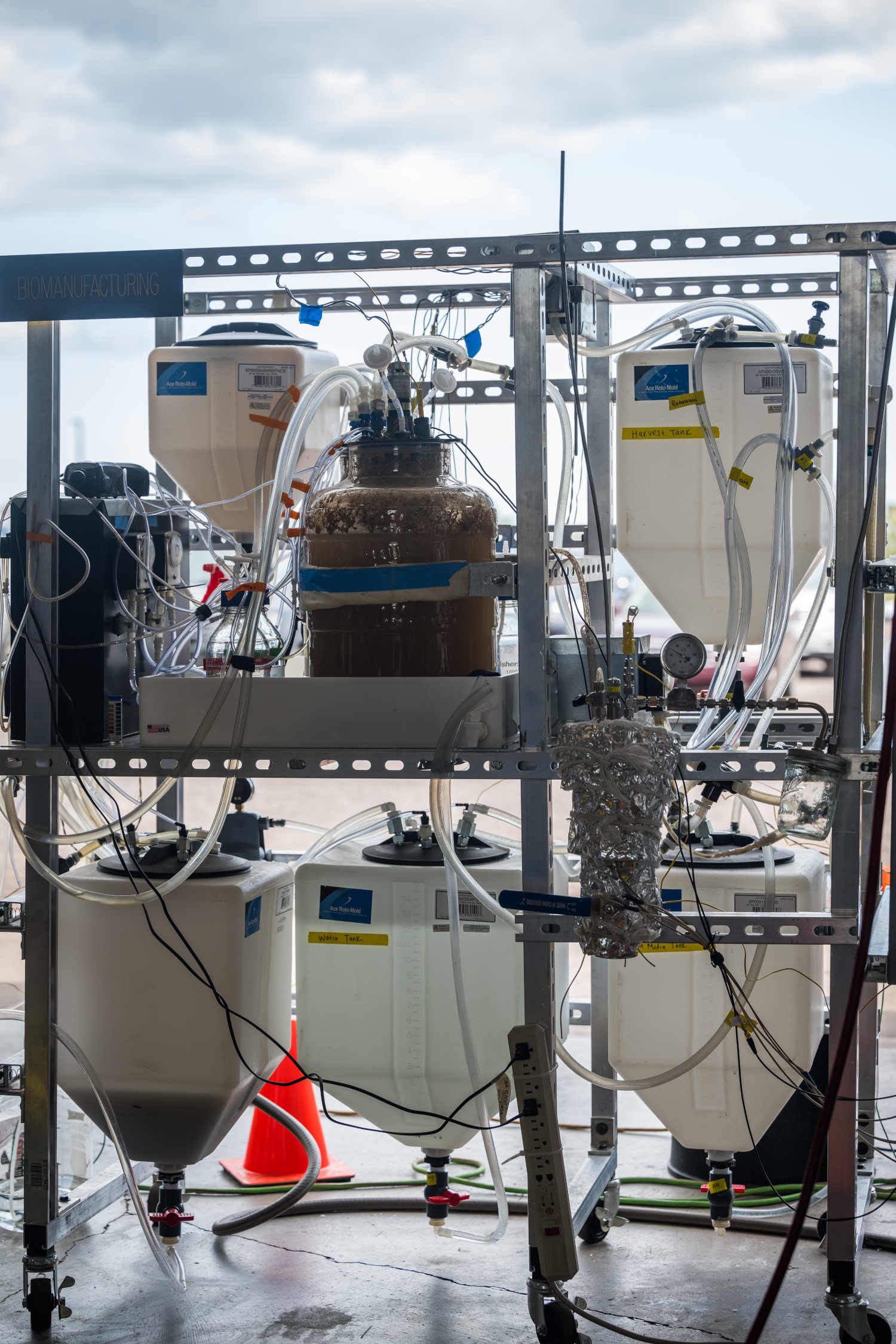Yves here. I know this idea may seem sound on some level, but I suspect most people would rather eat bugs than eat food made from bacteria that ate up plastic If nothing else, it has taken decades to work out that ultra processed foods like high fructose corn syrup are bad for you. Any bacteria-derived food intuitively seems so removed from what humans have evolved to consume, particularly in terms of diversity and almost certain lack of micro-nutrients, that it’s hard to see it as a good idea. And one can therefore further imagine that the affluent and the health conscious will reject this as “food”.
But the odds seem high that any “bacteria that ate plastics” calorie source will be fed to animals instead….which will lead to further bifurcation, of “grass fed”, “free range” or other non-Frankenfood fattened animal (or dairy) product for those that can afford it, and yet another variety of factory food for everyone else. The story effectively acknowledges this; the envisaged use is on a very short-term, emergency basis.
The article also mentions using reactors and “high heat” to process the plastics. What is the energy cost?
By Sara Talpos, a contributing editor at Undark. Originally published at Undark
In 2019, an agency within the U.S. Department of Defense released a call for research projects to help the military deal with the copious amount of plastic waste generated when troops are sent to work in remote locations or disaster zones. The agency wanted a system that could convert food wrappers and water bottles, among other things, into usable products, such as fuel and rations. The system needed to be small enough to fit in a Humvee and capable of running on little energy. It also needed to harness the power of plastic-eating microbes.
“When we started this project four years ago, the ideas were there. And in theory, it made sense,” said Stephen Techtmann, a microbiologist at Michigan Technological University, who leads one of the three research groups receiving funding. Nevertheless, he said, in the beginning, the effort “felt a lot more science-fiction than really something that would work.”
That uncertainty was key. The Defense Advanced Research Projects Agency, or DARPA, supports high-risk, high-reward projects. This means there’s a good chance that any individual effort will end in failure. But when a project does succeed, it has the potential to be a true scientific breakthrough. “Our goal is to go from disbelief, like, ‘You’re kidding me. You want to do what?’ to ‘You know, that might be actually feasible,’” said Leonard Tender, a program manager at DARPA who is overseeing the plastic waste projects.
The problems with plastic production and disposal are well known. According to the United Nations Environment Program, the world creates about 440 million tons of plastic waste per year. Much of it ends up in landfills or in the ocean, where microplastics, plastic pellets, and plastic bags pose a threat to wildlife. Many governments and experts agree that solving the problem will require reducing production, and some countries and U.S. states have additionally introduced policies to encourage recycling.
For years, scientists have also been experimenting with various species of plastic-eating bacteria. But DARPA is taking a slightly different approach in seeking a compact and mobile solution that uses plastic to create something else entirely: food for humans.
The goal, Techtmann hastens to add, is not to feed people plastic. Rather, the hope is that the plastic-devouring microbes in his system will themselves prove fit for human consumption. While Techtmann believes most of the project will be ready in a year or two, it’s this food step that could take longer. His team is currently doing toxicity testing, and then they will submit their results to the Food and Drug Administration for review. Even if all that goes smoothly, an additional challenge awaits. There’s an ick factor, said Techtmann, “that I think would have to be overcome.”
The military isn’t the only entity working to turn microbes into nutrition. From Korea to Finland, a small number of researchers, as well as some companies, are exploring whether microorganisms might one day help feed the world’s growing population.
According to Tender, DARPA’s call for proposals was aimed at solving two problems at once. First, the agency hoped to reduce what he called supply-chain vulnerability: During war, the military needs to transport supplies to troops in remote locations, which creates a safety risk for people in the vehicle. Additionally, the agency wanted to stop using hazardous burn pits as a means of dealing with plastic waste. “Getting those waste products off of those sites responsibly is a huge lift,” Tender said.
The Michigan Tech system begins with a mechanical shredder, which reduces the plastic to small shards that then move into a reactor, where they soak in ammonium hydroxide under high heat. Some plastics, such as PET, which is commonly used to make disposable water bottles, break down at this point. Other plastics used in military food packaging — namely polyethylene and polypropylene — are passed along to another reactor, where they are subject to much higher heat and an absence of oxygen.
Under these conditions, the polyethylene and polypropylene are converted into compounds that can be upcycled into fuels and lubricants. David Shonnard, a chemical engineer at Michigan Tech who oversaw this component of the project, has developed a startup company called Resurgent Innovation to commercialize some of the technology. (Other members of the research team, said Shonnard, are pursuing additional patents related to other parts of the system.)

After the PET has broken down in the ammonium hydroxide, the liquid is moved to another reactor, where it is consumed by a colony of microbes. Techtmann initially thought he would need to go to a highly contaminated environment to find bacteria capable of breaking down the deconstructed plastic. But as it turned out, bacteria from compost piles worked really well. This may be because the deconstructed plastic that enters the reactor has a similar molecular structure to some plant material compounds, he said. So the bacteria that would otherwise eat plants can perhaps instead draw their energy from the plastic.
After the bacteria consume the plastic, the microbes are then dried into a powder that smells a bit like nutritional yeast and has a balance of fats, carbohydrates, and proteins, said Techtmann.


Research into edible microorganisms dates back at least 60 years, but the body of evidence is decidedly small. (One review estimated that since 1961, an average of seven papers have been published per year.) Still, researchers in the field say there are good reasons for countries to consider microbes as a food source. Among other things, they are rich in protein, wrote Sang Yup Lee, a bioengineer and senior vice president for research at Korea Advanced Institute of Science and Technology, in an email to Undark. Lee and others have noted that growing microbes requires less land and water than conventional agriculture. Therefore, they might prove to be a more sustainable source of nutrition, particularly as the human population grows.
Lee reviewed a paper describing the microbial portion of the Michigan Tech project, and said that the group’s plans are feasible. But he pointed out a significant challenge: At the moment, only certain microorganisms are considered safe to eat, namely “those we have been eating thorough fermented food and beverages, such as lactic acid bacteria, bacillus, some yeasts.” But these don’t degrade plastics.
Before using the plastic-eating microbes as food for humans, the research team will submit evidence to regulators indicating that the substance is safe. Joshua Pearce, an electrical engineer at Western University in Ontario, Canada, performed the initial toxicology screening, breaking the microbes down into smaller pieces, which they compared against known toxins.
“We’re pretty sure there’s nothing bad in there,” said Pearce. He added that the microbes have also been fed to C. elegans roundworms without apparent ill-effects, and the team is currently looking at how rats do when they consume the microbes over the longer term. If the rats do well, then the next step would be to submit data to the Food and Drug Administration for review.
At least a handful of companies are in various stages of commercializing new varieties of edible microbes. A Finnish startup, Solar Foods, for example, has taken a bacterium found in nature and created a powdery product with a mustard brown hue that has been approved for use in Singapore. In an email to Undark, chief experience officer Laura Sinisalo said that the company has applied for approval in the E.U. and the U.K., as well as in the U.S., where it hopes to enter the market by the end of this year.
Even if the plastic-eating microbes turn out to be safe for human consumption, Techtmann said, the public might still balk at the prospect of eating something nourished on plastic waste. For this reason, he said, this particular group of microbes might prove most useful on remote military bases or during disaster relief, where it could be consumed short-term, to help people survive.
“I think there’s a bit less of a concern about the ick factor,” said Techtmann, “if it’s really just, ‘This is going to keep me alive for another day or two.’”


Why not add the flux capacitor, to go with this Mr. Fusion, while you’re at it? All those Humvees in Kursk could really use it, while working in remote locations or disaster zones.
The ultra processed food industry was birth with the same playbook as Big Tobacco. They knew. It was intentional. Many know this and when the alarm was sounded, the messengers were silenced because people pretended not to hear. All this sickness and illness? It’s called Karma in this natural world.
To all the evolutionists, which I am not, I agree with your holy mantra: Survival of the fittest.
This doctor is a neuroendocrinologist at UCSF
https://robertlustig.com/tobacco-playbook/
or
this ‘mere dentist’ who passed from this life in 1948.
https://www.westonaprice.org/#gsc.tab=0
Commonly used as a food coloring, carmine is a dried powder of the creepy-crawly cochineal, a cactus parasite. Unless it’s prominently listed as an ingredient, people don’t care what’s in their food.
I’d rather eat roasted crickets. At least that is a food in some places. The petro-chemical industry continues to churn out as much plastic as they can and in the US want to expand their facilities. Turning plastic waste into “food” will enable this model to continue. But when I read the title, I was reminded of a section of a book called “Catch 22.” In it, business hustler Milo Minderbinder gets caught short by buying too much cotton from Egypt so is looking for a way to get rid of it to reduce his financial liabilities. So he thinks of getting balls of cotton with chocolate and forcing people to eat it. This is the same sort of thinking-
https://www.youtube.com/watch?v=Jcx-bSyJpYk (47 secs)
I have not yet read the article, but I have to say, the headline and Yves intro made me think of Bill McKibben’s great book, “Enough”, and the whole notion of the Kurzweilian Singularity (we are in it, and past the predicted date of machine and man merging).
My thought, “Well, of course we can. Look at what we have done thus far!!”
Musk’s brain implants, looking at the average Joe in our midst and his 24/7 constant view of the gizmo in hand, the dowager’s hump change in human carriage and stature as we crane our necks to longingly receive affirmation that we exist- they all make me think we have arrived in Kurzweil’s Marvelous Funhouse.
Remember the scene in The Graduate—- “One word, Benjamin–Plastics!”
It’s a self licking ice cream cone ( SLICC) for the oil and gas folks. The more I ponder Oil and Gas— and I have made a living circling that drain… amazing stuff, from the bowels of the earth.
Truly, metaphorically and in fact- the Devil’s Brew. I have given another twist to my already addled brain and my pattern of taking the cynics view of the world- follow the money. Really, it’s follow the Oil.
A lot of the plastic has colorful printed paper labels. What happens when you recycle plastic with labels? What’s in the inks and the glue that holds the labels to the plastic? Does this also get eaten by the microbes? Is any of this safe for human food?
It’s looking increasingly likely that either industrial civilization disintegrates or becomes a Dead Head’s bad trip.
cf Kit Pedler’s 1972 Mutant 59: The Plastic Eaters.
Maybe just cut out all the middlemen and sew my mouth directly onto the person in front of me? If I’m going to eat nothing but shit provided by our betters, I may as well take what enjoyment I can from knowing I’m in the Human Centipede.
“We’re pretty sure there’s nothing bad in there,” says it all. They have no idea what is in there, have not done any chemical analysis, just note it didn’t kill the worms in the (short??) time of exposure (single?). Worse, it will probably be approved as Safe and Effective!
I wonder why they didn’t just spend a few hundred bucks and get an analysis for petroleum hydrocarbon derivatives.
Remember that time Oog and Grr were sitting around wondering if the mushrooms were edible? That’s kind of what this reminds me of, except lab coats. And they try it out on rats first, because of the pussification of America. And don’t get me started on achievement trophies and second grade graduations.
I’d eat plastic bacteria poop, what the hell, already got microplastics in the water and food and air probably. I can mix it in with my AG1 powder shake. I bet they’ll find it whitens teeth also, once they mix the tooth whitening chemical in with it anyway.
And nanomachines with AIs so that my insides can be under constant surveillance and, bonusly, so i can be remotely piloted in case of… broken glass or something.
Living in the future rocks.
I’m skeptical like everyone else, but not actually as much about the scientific side of it. Everything they described here really isn’t a new discovery. My understanding is it’s always been the economics of scaling up & post-processing that’s held these technologies back.
I’ve never had the space or resources yet in life, but I’ve always dreamed of being a hobby chemist, and plastics decomposition is one of the main things I want to try.
The bacteria they’re describing are probably creating leaf-and-branch compost cutinase. It turns out the same enzyme that eats up the tougher parts of dead underbrush is really good at chewing through several other (but not all) polymers.
And IIUC the pyrolysis reactor is just a large vacuum crucible that gets refilled with pure nitrogen after it’s loaded. Then you cook the plastic down (no oxygen = no combustion) at a high temperature, but not that high compared to a lot of industrial processes. It might even be possible to do with solar reflectors.
I think the real issue with pyrolized fuel is that after you pull off the gases (methane, ethane, etc.), you’re left with a *really* heavy grade of crude oil and a significant residue of carbon black (nasty stuff).
As for directly feeding people plastic compost, yeah, that’s weird. I’d think it would make more sense to market as a soil additive for marginal land or something. I remember seeing a documentary about California’s wastewater plant that can reclaim sewage. Even though they claim water is cleaner from the plant than untreated from the reservoir, it’s politically simpler to give nature another pass at it & just pump it into the reservoir
I eat my plastic packaging directly. Just finished blister-pack I got with my new iPhone, and intend to eat the phone, too, once the new model comes out. For dessert, I’ll have the plastic bag the tomorrows dinner of soda bottles came in. I have good teeth, chew all my food thoroughly, and it has a complete balance of fats, carbohydrates, and proteins. I don’t waste my time running it through a roundworm first because you have to sautee them in a bit of WTI (West Texas Intermedia) for patriotic reasons.